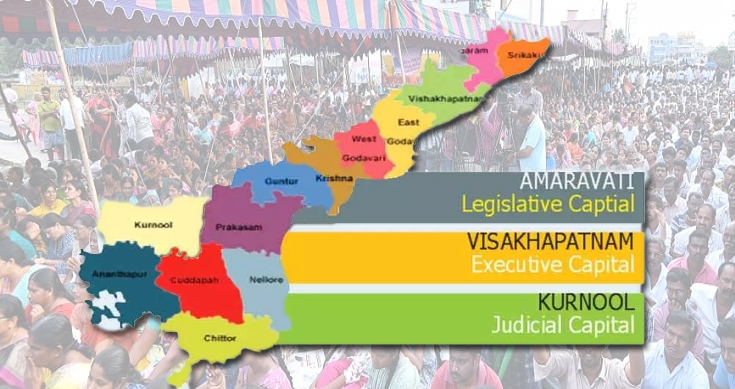Andhra Pradesh, a re-formed state after bifurcation from Telangana region since 2014 is now newly debating whether it should have one capital city in Amaravathi, or three capital cities across the state. Although an agreement has made for Hyderabad to act as a capital city for both the states, Andhra Pradesh and Telangana for a maximum period of 10 years, signs of declaring a capital city for Andhra Pradesh are yet to be discovered.
It all started in 16 November 1937 with the agreement of Sribagh pact in Sribagh between the political leaders of the Coastal Andhra and Rayalaseema regions during the separation of Andhra Pradesh province from Madras State. The pact mainly focus upon the University – demanding to develop two University centres, one at Vizag and another at Ananthapur district so as to distribute the culture and education among Andhra’s in areas favourable to the subjects dealt with, irrigation – development of the agriculture and economic interests of Nellore and Rayalaseema regions should be done parallel with those of coastal regions, whenever the question of sharing water arise, the needs of Rayalaseema are to be first met, legislature – distribution of seats equally without bias and decentralization of the High court in order to develop the regions. It shall, however, be open to vary these terms by common consent. On 1 October, 1953 , Andhra state was formed with Kurnool as the capital and the Guntur with High court under the terms of Sribagh pact.
While the Sribagh pact was made between Costal Andhra and Rayalaseema leaders, the Gentleman’s agreement was made between the Andhra and Telangana leaders on 20 Febraury,1956 when the Telugu speaking states were reorganised the Telugu speaking areas of Hyderabad state proposed to merge with Andhra state. This agreement was made at Hyderabad House in New Delhi under the scope of the Prime Minister Jawaharlal Nehru to safeguard the rights of Telangana region. After the formation of Andhra Pradesh state in 1956, both the capital city and high court were moved to Hyderabad, Telangana.
Meanwhile the newly formed state was busy developing the areas adjacent to the capital city, Hyderabad the other regions such as coastal Andhra and Rayalaseema were left unnoticed. on 2 June 2014, due to Telangana movement the Andhra Pradesh Reorganisation Act, 2014 commonly known as Telangana Act came into existence that bifurcate the state of Andhra Pradesh into Telangana and the residuary state of Andhra Pradesh leaving many cities of residuary state undeveloped. On 4 September 2014, then Chief Minister of newly formed Andhra Pradesh state Nara Chandrababu Naidu, declared in the Legislative Assembly that the new capital of Andhra Pradesh would come up between Guntur and Vijayawada regions. On 1 April, 2015 the capital city was named as Amaravati.
After 5 years into the development of the new capital city to the state, with the dissolution of Chandrababu Naidu’s government it was noticed that only the visualisations have been produced far more with the least of actual development. there by present Andhra Pradesh Chief Minister Mr. Y.S Jagan Mohan Reddy has taken a huge step to develop three capital regions simultaneously favouring the backward developed regions in parallel with coastal regions considering Sribagh pact that was made few decades ago which raised hopes in the lives of Rayalaseema region people and the Gentleman’s agreement that left the very same areas unnoticed and undeveloped.
The government on 17 December, 2019 has proposed to retain Amaravathi as the legislative capital, while making Vishakapatanam the home for executive and Kurnool the judicial capital. Although the idea of more than one capital has been followed in many states like Rajasthan and Maharastra. The Andhra Pradesh cabinet chaired by Mr. Reddy approved the proposal on three capital cities aimed at “decentralised and inclusive development of all regions of the state”. It also approved repealing the Capital Region Development Authority(CRDA) act and establish the Amaravathi Metropolitan Development Authority as a whole. The bill placed before the assembly for its approval clearly says “The logical solution would be to lay emphasis on distributed development and decentralised administration to ensure that the fruits of socioeconomic progress are enjoyed equally by people of various regions” which shows another great impact on approval of the bill.
However, the opposition on the other hand has triggered the capitalists and industrialists on 18 December, 2019 in the region of Amaravathi leading to the ongoing “Amaravathi protests” against Andhra Pradesh Decentralisation and inclusive development of All Regions Bill, 2020. It is believed that the protests arouse mainly due to the caste disputes where the back step of one capital ideology affects the investments on land mostly owned by the Khamma community in the Amaravathi region. Alla Ayodhya Rami Reddy, an MP representing the ruling government asks “Is it exclusion or inclusion,” in favouring the accessibility of capital city to all regions.
Havila Reddy @Samacharline









